| Assignment
#3
Scenarios
Revised
Personas
Comparative Analysis
Interaction
Flow Diagrams
Initial
Sketches
Appendix
Comparative
Analysis
What is a portal?
Horizontal Portals - AOL for Broadband
and My.Yahoo
Vertical Niche Portals - WebMD and Covisint
Enterprise Portals - e.piphany and
MyUW
Standard Educational Channels
RSS Feeds
Cameo Channels
Influencing Trends in Educational
Technology e-portfolios and Course Management Software
"A homepage doth not a
portal make" - Howard Strauss 03.01
What
is a portal?
Portals have fundamentally changed the way information is presented
on the web. In the earliest versions of the web, organizations
presented a one-size-fits-all webpage. Advances in web services
in 2000 and 2001 enabled a greater degree of interactivity,
but the user still had to know how to navigate to or browse
for information that is relevant to her. The portal limits the
type of information available to a user based on their role
and then allows the user to select and arrange the informational
components that are most important to her. The net effect is
that each person has a webpage that is customized to her needs
and tastes.
The major types of Portals are:
Horizontal
Portals
These are generally offered by Internet Service Providers or
Search Engines as a central location for frequently used links.
We chose to review two Horizontal portals: AOL for Broadband,
an ISP content provider for users with a high-speed internet
connection and my.yahoo, a search engine providing customizable
home pages.
AOL for Broadband
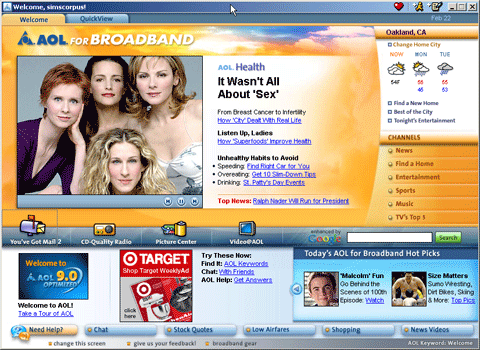 Main
page Main
page
AOL for Broadband is a relatively new service provided by AOL
targeted at high-speed internet users that are looking for a
all-in-one Internet application. AOL for broadband combines
a browser, email client, and community functions like chat and
bulletin boards.
Pros:
- Information navigation is easy. Every setting and topic
has a single keyword that can be used in the search feature
to subsequently locate the information.
- Search bar, enhanced by google on front page.
- Integrates features well. Users can easily insert a link
or a video into an email, send an IM or add it to your favorites
with one click of the mouse.
- Uses a desktop and window metaphor for the browser functions.
Each linked article opens in a new window within the AOL browswer
(i.e. there is only one AOL item on the taskbar). Those windows
can be moved, minimized and closed. There are some limits
to the metaphor however, for instance it is not possible to
use 'right click' on links or images.
- Unique community features integrated with portal. For instance,
the 'Send Out a Shout' feature shown below presents a question
for users and allows them to submit a comment. The comment
is then broadcast to everyone with the 'Send out a Shout'
feature activated (It also appeared to have some automated
review feature for inappropriate content).
 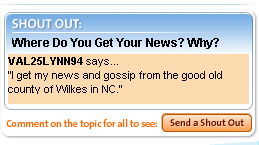 Shout Out: A unique feature
Shout Out: A unique feature
- Settings for every AOL tool were located in one place and
could be accessed by one of three methods: essentials, by
category, and an alphabetical list by feature name.
Cons:
- Initially content is setup with "canned" interests.
While this enabled quick sign up, the interest topics were
very narrow (financial, entertainment, nightlife, small business).
- Weather only available for one designated “home city.”
- Feature navigation did not follow consistent logic. The
user can get to the same feature from multiple places making
remembering where to find things difficult.
- AOL window is one item on PC task bar, but multiple windows
could be open within that window. Having too many windows
open gets confusing as shown below. Additionally, it is difficult
to review what windows are open.
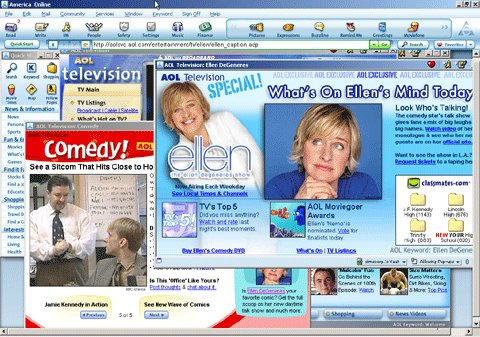 Too many windows open!
Too many windows open!
- Features associated with icons are not intuitive. The 'Write'
icon maps to the email program and no other programs such
as a notepad. The 'People' icon opens 'People Connection'
a page that brings together celebrity entertainment news and
chat applications. It also has quick links to manage the user
profile there. (Return to Top)
My.Yahoo
Yahoo! is a prominent search engine that provides its users
with the ability to centralize much of the information they
need on the web. Like AOL for Broadband, they also provide a
number of other Internet applications such as webmail, calendaring
functions, and bookmark management.
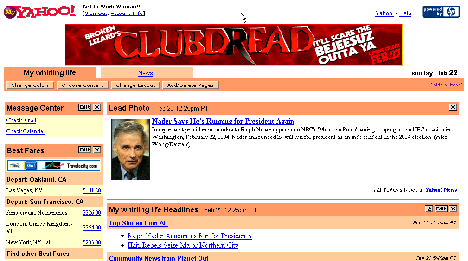 Main page
Main page
Pros:
- Style is predictable and consistent throughout site. Instructions
and menus were well placed. Feedback on errors was helpful
and not disruptive. For instance, when a module was removed
from their service offering they broadcast a message saying
it is no longer supported rather than just removing it.
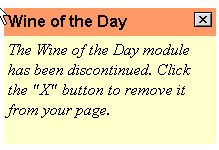 Outdated cameo
Outdated cameo
- Good balance between reuse of user information and privacy.
The mapping feature is a good example of this. It saves the
most recently mapped addresses to facilitate mapping them
again. While providing a clearly visible option to clear mapping
history as well.
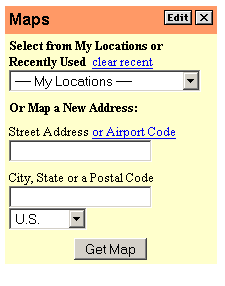 Map
Cameo Map
Cameo
- Weather channel allows multiple city setup and easy search
feature by city name or zip code
- Setting up features is streamlined and intuitive. When changing
the content and layout of my.yahoo, available and chosen channels
are easy to review and change. Modules are labeled as narrow
or wide so that users can maximize layout space. Unlike other
products we looked at, navigation between content setup and
layout is easy. It also has a number of 'on the fly' features
for setup that are well placed and can be hidden.
- Nice preview feature of colors chosen for customized color
scheme.
- Unique cameos, or mini-applications, available. Cameos provide
a limited amount of functionality without having to go to
or spawn another window. Results can be shown directly within
the channel. My.yahoo has a number of unusual but helpful
cameos such as a package tracker, saved searches, and Evite,
a third party event planning website.
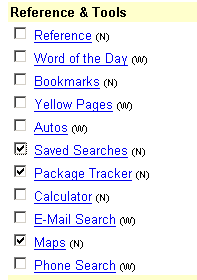 Available
Cameos Available
Cameos  Evite Cameo
Evite Cameo
- Currently beta testing allowing users to add custom RSS
(Rich Site Summary) feeds in addition to pre-defined news
channels. RSS feeds provide highly flexible
access to information sources.
Cons:
- Very general content, not much option to specialize information,
however this is the nature of a horizontal portal.
- Layout is busy. (Return to Top)
Vertical Niche
Portals
Vertical Niche Portals are designed to serve an audience with
a very specific interest. The most common types of vertical
niche portals are those focusing on a specific topic such as
WebMD, which provides medical information for patients and doctors,
or catering to a particular industry like Covisint, a business-to-business
portal for the auto industry.
WebMD
WebMD provides information and services to assist physicians,
patients and health plan providers manage the complex healthcare
system. They provide a comprehensive medial library for reference,
patient subscriptions for services such as weight loss and fertility,
and a desktop application for physician billing. We focused
on My WebMD, a customizable service for patients.
 Main page
Main page
Pros:
- The Site conceives of medical information in its broadest
definition—health care, diagnosis, health maintenance,
products, etc. They provide a great deal of medical information
which is beneficial especially if you know what you are looking
for.
- Information includes trends in the medical industry and
various opinions on those trends.
Cons:
- No information channels available for My WebMD page. Information
feeds are only available as email newsletters.
- Navigation through the site is counter-intuitive. Features
of one section are actually part of another component making
it hard to know what parts of the site you have already seen.
When you click on the symptom checker, shown below, for example,
a window with a header that says medical library is the next
thing you see.
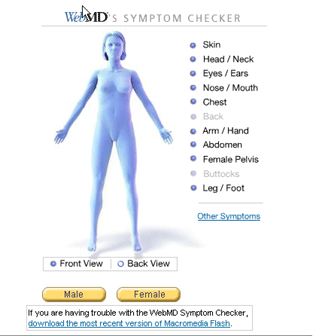 Symptom Checker
Symptom Checker
- Benefits for registration are unclear. A registered user
does not receive much more functionality than an unregistered
user. Most of the useful applications require a subscription
and have a free trial. Unfortunately however, the subscription/free
trial has yet another registration process that requires much
of the information same information that was just entered
upon registering for My WebMD. (Return to Top)
Covisint
The Covisint product line is divided into three categories:
Connect. Communicate. Collaborate. Their portal product
comprises the communication component and attempts to be an
informational nexus individuals in the automotive industry.
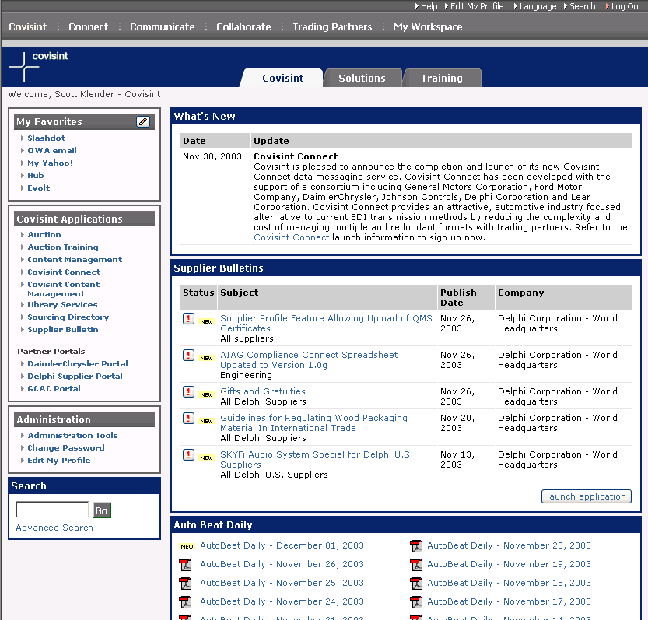 Main page
Main page
Pros:
- Very targeted information based on organizational relationships
and individual user roles.
- Based on a user's role, content setup makes recommendations
about which content would be most important to a given user.
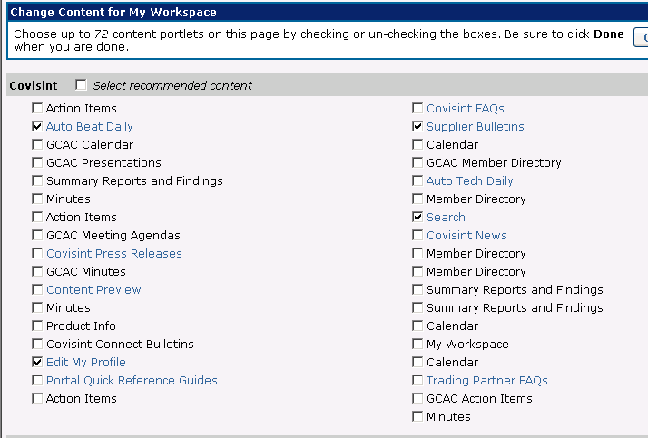 Customize
Customize
- Providers of content can brand the look of their content
on a customized portal. Trading partners can add their logo
and change the color scheme that their customers see.
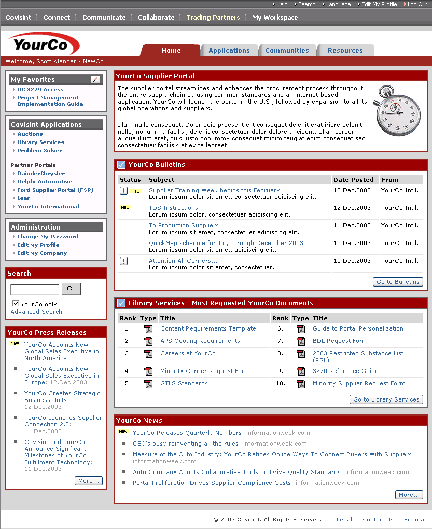 Trading partner page
Trading partner page
Cons:
- Rather than actual Cameo Applications that would allow
some functionality on the homepage, Covisint applications
launch in separate window.
- Information might be too comprehensive to browse making
search functions more important. (Return to
Top)
Enterprise
Portals
Enterprise portals deliver organization-specific information
in a user centric manner and can incorporate the best features
of the other two types of portals. Additionally, due to the
authentication process, the portal application can know a good
deal about the user and the types of information a user of that
sort will want. In addition to presentation change, the enterprise
portal is often portable between hardware formats like a PC
and PDA. Lastly, this type of portal tends to aggregate content
from internal and external resources. We looked at two types
of enterprise portals for comparison: e.piphany savant, a tool
for e.piphany employees, and MyUW, which provides University
of Washington's diverse student, faculty, employee community
with important university information.
e.piphany Savant 2.5
e.piphany is a company whose products include a suite of Customer
Relationship Management tools. Internally, they provide e.piphany
Savant for their employees to manage personal and shared information.
The tool incorporates the functionality of an email client,
calendaring program, contact management, and search engine.

Pros:
- Simple content setup. Wizard highlights the most important
features. Easy to identify which features have been added
and which remain. Accommodates advanced users with 'Finish'
button so that they may exit the wizard gracefully.
- Layout and presentation are easy to modify. Each gadget
is noted whether it is narrow or wide. Also easy to add/remove
columns with preview of what it will look like (radio button
seems like good technique for this). Color customization easy
to review and see how various components will look.
- Assists with navigating company content. The portal provides
both document search capability and the ability to save your
searches.
- Well designed people search cameo. The user can search or
browse for contacts from multiple directories all in one location.
It also allows for search by first name which is a nice organizational-centric
customization.
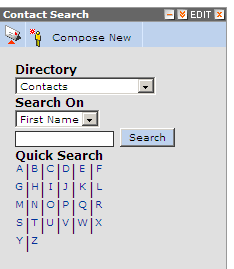 Contact Search
Cameo Contact Search
Cameo
Cons:
- Page layout and content can not be edited 'on the fly.'
Only pre-defined color schemes available.
- Channels are called gadgets, might not be intuitive name
for users. (Return to Top)
MyUW
MyUW is a comprehensive portal to University of Washington
information for all campuses. It is available to students, faculty,
and staff. It also provides access to frequently used UW applications
such as Pine, an SSH email client, campus directories.
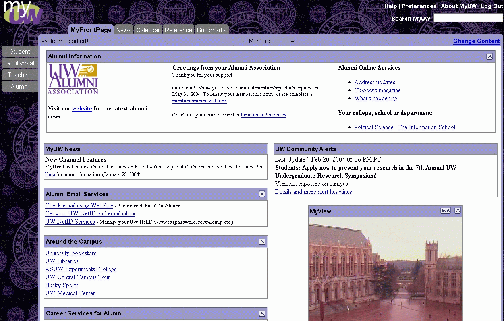
Pros:
- Very comprehensive information source. Ranges from most
general of National News, Local News, Countrywide University
News, UW news, to specific UW organization news. Navigation
is possible based on your role (Student, Faculty, Alumni)
or the specific information a user seeks (News, calendar).
This helps to provide context for the wealth of information
available. The portal provides access to the bulk of information
a student, faculty, or staff member would need to access UW
resources.
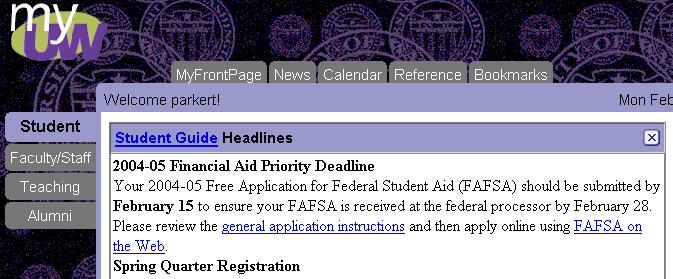
- Allows users to add custom bookmarks to the front page.
Cons:
- While very comprehensive, the portal is a collection of
links. Applications open in new pages rather than from within
the channel.
- Content is assigned to fixed locations within the portal.
Users cannot customize names of tabs or what information can
appear there. Therefore it is not possible to group informational
items together according to userneeds. However, users can
customize which tab the application defaults to when they
log in.
- Page layouts easily become busy. While its nice that all
of the available information is centralized on one page, its
difficult to navigate what information is available during
setup. Below is a screenshot that shows approximately one-quarter
of the information channels that are available for the front
page alone. Also, there is not an option to see or customize
layout. (Return to Top)
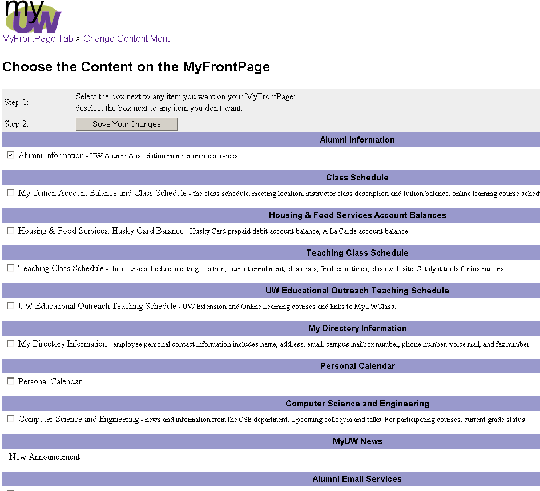
Content
Another aspect important to our project is providing helpful
and relevant content for SIMS students that will encourage the
use of a MySims page. Content in portals is provided in entities
called channels that allow users to easily add, remove, or change
the layout of various content components.(Return
to Top)
Standard
Channels
We surveyed a number of educational enterprise portals and
found that most sites contain the standard channels listed below.
We have included a screen shot from the versions we thought
were most effective and a few notes about their limitations.
Texas Tech provides an easily editable calendar channel for
students. Users are able to add events from the view calendar
mode. Required fields are designated and frequently used locations
can be saved.
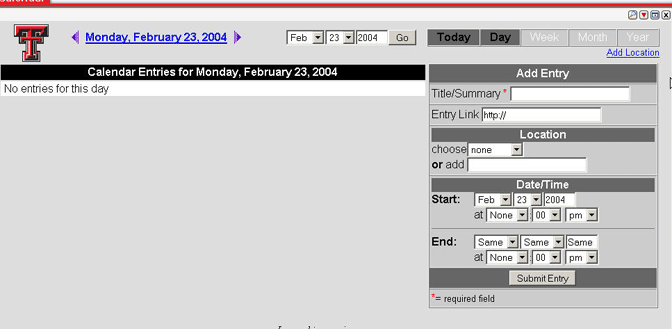
The Univeristy of Hong Kong uses a standard format for their
email client. Of the email clients we found during our research,
this version made the best use of space without being excessively
cluttered.
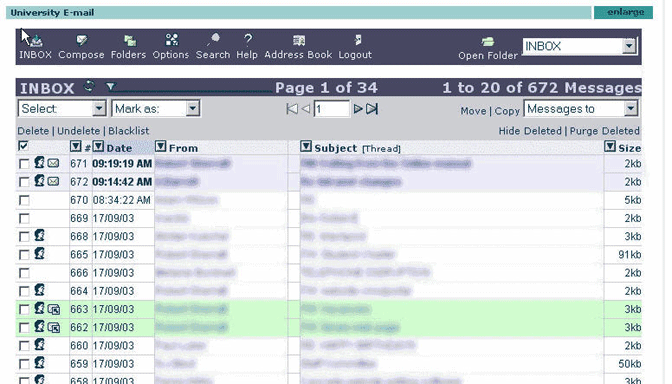
YaleInfo allows students to subscribe to various news sources
and then view all of the items from a specific source. Knowing
the source of the information is helpful, but could be better
if it were sortable by topic and source in the general overview.

Deakin University's news feature has good division between
sources. It is easy to tell the source of an article and whether
or not the news item has been read, however it wastes a lot
of space on the screen.
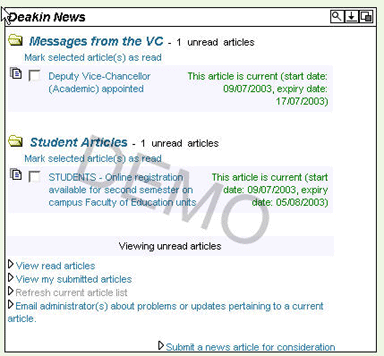 Deakin
University News Channel Deakin
University News Channel
Two features seemed particularly salient for a weather channel:
forecasts and viewing the weather for multiple cities. Virginia
Tech's calendar uses graphics and simple text to allow the user
to easily see the 3-day forecast.
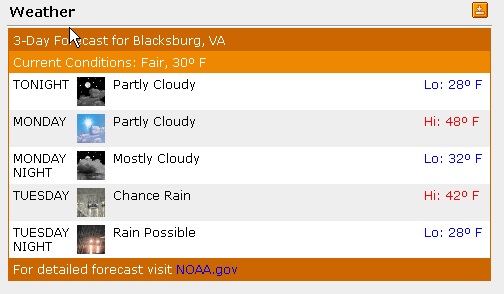 Virginia
Tech Weather Channel Virginia
Tech Weather Channel
Another feature that seemed important for Bay Area residents
is being able to see the weather for multiple cities like Deakin's
weather channel below. It provides detailed current weather
information, perhaps too detailed, but also allows users to
show weather for multiple cities.
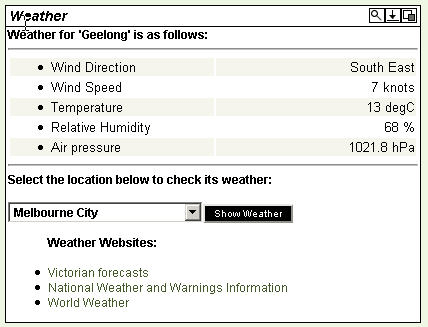 Deakin
University Weather Channel Deakin
University Weather Channel
- Bookmarks allow users to collect URL's that are important
to their academic and personal lives. CalPoly's uses a standard
format for their bookmark channel, show below, uses file folders
as a metaphor for organization. The folders enable the user
to see the hierarchy of links.
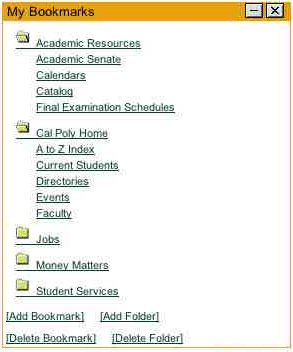 Cal
Poly Bookmark Channel Cal
Poly Bookmark Channel
Most educational portals incorporate some search feature. Cal
Poly uses a google search engine and allows students to designate
the body of information to be searched between general WWW and
just within the Cal Poly community. It also provides access
to other reference resources such as directories and an index.
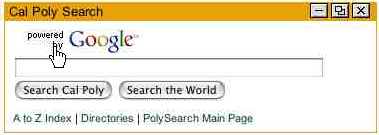 Cal
Poly Search Channel Cal
Poly Search Channel
In addition to these standard channels, we began to brainstorm
based on our interviews with students and our own experiences
as students about other information that would be useful on
a customizable student portal. (Return to Top)
RSS Feeds
RSS stands for Rich Site Summary and is an XML format for syndicating
Web content. Traditionally, if a web site owner wanted to allow
other sites to publish some of its content, he would create
a RSS document and register it with a RSS publisher. The most
frequently syndicated content includes items such as announcements,
events listings, news stories and headlines, project updates,
excerpts from discussion forums or blogs. Recently, however,
the most exciting development in RSS feeds is that they no longer
need to be published. Websites like NewsTrove and MyRSS are
allowing users to build custom RSS feeds. In the case of NewsTrove,
they provide a search engine that indexes and categorizes news
articles gathered twenty-four hours per day from over 25,000
individual high-quality news sources. Custom RSS feeds can then
be built from searches on their database. The feed address can
then be added to any news reader and be treated as a regular
news source. We believe tools like this will allow the information
available to users to be highly customized and thus more useful.
(Return to Top)
Cameo
Channels
Almost if not as important as access to information are the
tools used to manage it. Cameos are abbreviated versions of
applications that run within a channel on a portal. Cameos allow
users to work centrally without opening a number of applications.
In the course of our research, we found a number of interesting
ideas for cameo channels. They are described below:
- Campus Map feature allows the user to select a location
and see where it is located on the map. The map is launched
in another browser window.

- Library Collection Search allows a user to search by title,
keyword, or subject. Advanced search capabilities to limit
search to certain formats or libraries might also be desirable.

- Student Poll is similar to the 'Shout Out' tool in the AOL
for Broadband package. It seems helpful for building community
amongst users.
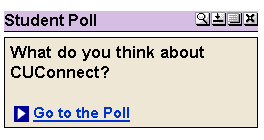
- Calculator is a frequently used tool that can be beneficial
to have on a desktop. Can also be minimized when not in use.
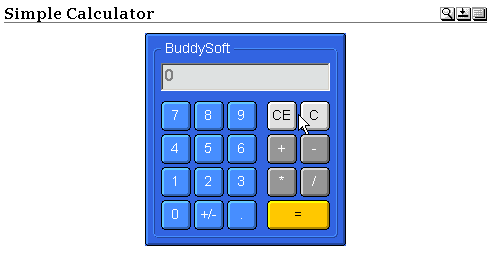
- Games like this old classic need not stay on your PC desktop.
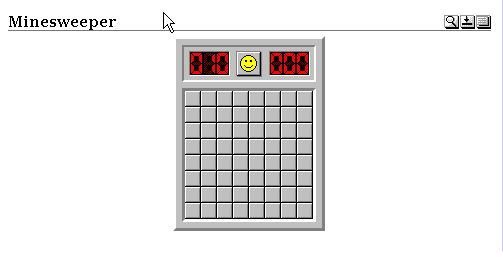
(Return to Top)
Two Influencing
Trends in Educational Software
e-Portfolios
A more general trend in education are applications called ‘e-portfolios.’
Usually, they are highly personalized, customizable, web-based
information management system that allows students to demonstrate
skill development and academic achievements over time.
Typical Features for an e-portfolio are:
• Academic Advising and Planning
• Career and Resume Planning
• Create Learning Communities (to share and manage information)
• Integration (encourage involvement in curricular programs,
student groups)
• Life-long Learning Tool
• Program Evaluation
• Reflection on Coursework; Demonstrate Mastery
• Student Evaluation and Grading (publish multi-media
projects)
• Teaching Portfolios (teacher evaluation tool)
While these features are not within the scope of our current
project, we could see how a MySims portal could incorporate
academic planning and skill development modules as e-portfolio
systems are developed and deployed.
Course Management Software
 Blackboard
Blackboard
Course management software assists faculty and others who maintain
class resources for students. It centralizes access to course
notes, URL's, related documents, and course bulletin boards
for discussion without those managing the class having to invest
a lot of time in website creation and maintenance. This functionality,
like e-portfolios, is also beyond the scope of our current project.
However, if course deadlines and announcements were formatted
into an RSS feed they could then be subscribed to like any other
source of announcements. (Return to Top)
|

